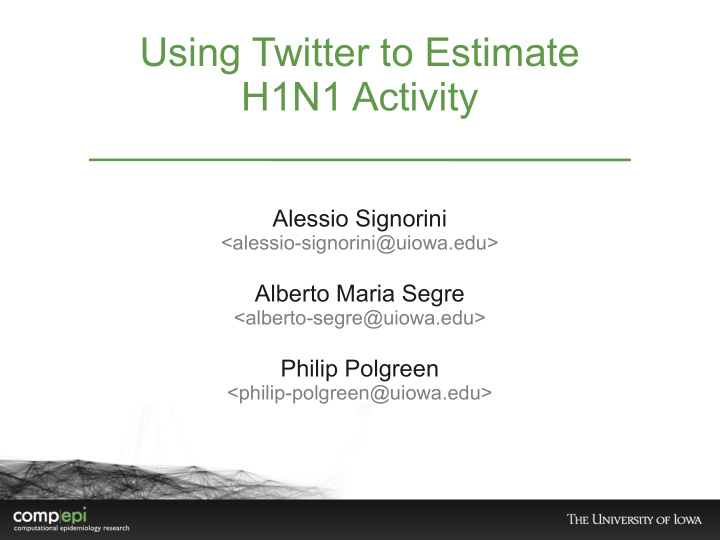



Using Twitter to Estimate H1N1 Activity Alessio Signorini <alessio-signorini@uiowa.edu> Alberto Maria Segre <alberto-segre@uiowa.edu> Philip Polgreen <philip-polgreen@uiowa.edu>
Thousands of Health Websites
Playing Doctor on Google Flu Searches flu symptoms, stomach flu, flu duration, flu treatment, how long does the flu last, cold, pneumonia, fever, bronchitis, influenza, tamiflu, strep throat Cough Searches bronchitis, pneumonia, cold, tuberculosis, flu, sneeze, dry cough, cough medicine, whooping cough, chronic cough, cough remedies, cough treatment, acute cough Headache Searches sinus headache, headache causes, headache types, headache remedies, headache cures, headache treatment, headache back of head, migraine, brain tumor, meningitis
More Health Queries = Sick? http://www.google.com/trends
Google Flu Trends (2009) http://www.google.org/flutrends/ Philip Polgreen and Yahoo! Research published similar results in 2008.
Luckily, Twitter was Invented Personal Micro-Blog for Short Status Updates (~ 60 Million per day!) People share lots of information: where they are, what they are doing, with whom, what they are eating, how they feel, ...
H1N1 2009: Tweets Volume CDC recommends Pandemic canceling travels plans level raised to 5 Number of confirmed cases reach 1000
American Idol: Queries vs. Twitter Google query volume declared Adam Lambert as winner but tweet sentiment analysis suggested Kris Allen would win.
Tweets are Often Messy Non-English Non-ASCII Out of US Spam Jargon
Typos and Stemming Tweets contains plenty of typos and misspellings (e.g., migrane, flue, cought, …) We decided to eliminate any term with only a few occurrences in each week. Words can be Inflected or Derived (e.g., ill, illness, sick, sickest, ...) The process of reducing words to their root is called Stemming. Many algorithms exists, we used the well-known Porter Algorithm.
Few Words are Really Important Stopwords are usually not relevant we excluded the most common during our analysis (e.g., the, and, with, of, …) Our first experiment tracked only tweets containing words correlated with influenza (e.g., flu, h1n1, influenza, cough, tamiflu, …) A later experiment tracked a random 5% sample of all tweets but noise was overwhelming.
Support Vector Regression Support Vector Machines (SVM) are a set of supervised learning methods used for classification and regression. Classification Regression http://www.imtech.res.in/raghava/rbpred http://kernelsvm.tripod.com/
Training and Testing We used the popular libSVM library and a polynomial kernel. The dataset included 32 weeks of data, about 4.2M tweets. We used n-fold validation. Our target was the weighted ILI% for each week. at first of the entire US, then of each HHS region. Examples of highly-correlated terms: flu, cough, shot, immun, sick, vaccin, school, sneez, virus, germ, wash, pregnant, ...
Reported vs. Predicted (US) 1-fold validation ~ error avg=0.28%, min=0.04%, max=0.93%. Std=0.23%
User/Tweet Geolocation Tweets are often tagged with the geographical coordinates of the user who sent them. Last year this technology was not widely adopted. When geolocation was not available, we used the location declared in the user's profile.
Reported vs. Predicted (NY+NJ) Out-of-sample Prediction ~ error avg=0.37%, min=0.01%, max=1.25%. Std=0.26%
Where to Get More Information Alessio Signorini alessio-signorini@uiowa.edu http://www.cs.uiowa.edu/~asignori/ UIOWA Computational Epidemiology Group http://compepi.cs.uiowa.edu paper and datasets will be soon available on the CompEpi website
Recommend
More recommend